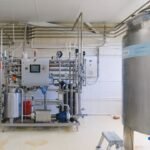Turbines are the heart of many industrial processes, from power generation to manufacturing. Whether you’re managing wind turbines, steam turbines, or gas turbines, their efficiency and performance are crucial to operational success. However, like any complex machinery, turbines require consistent care to ensure they function at their best. Regular maintenance not only helps prevent costly repairs but also maximizes efficiency and extends the lifespan of the equipment.
In this blog post, we will explore key maintenance strategies that can help maximize turbine performance.
1. Regular Inspection and Monitoring
The foundation of effective turbine maintenance lies in routine inspections and monitoring. These practices allow you to detect any potential issues early, before they evolve into costly failures.
- Visual Inspections: Regularly examine the turbine for visible signs of wear and tear. Check for leaks, abnormal vibrations, unusual noises, or any components that seem out of alignment. These could indicate that something is wrong and requires attention.
- Vibration Analysis: Excessive vibrations can be a sign of misalignment or imbalance within the turbine. Using vibration sensors, operators can monitor vibrations in real time and take corrective action before significant damage occurs.
- Temperature Monitoring: Temperature is a critical indicator of turbine performance. Elevated temperatures can signal problems like insufficient lubrication or mechanical friction. Monitoring temperature levels helps identify potential issues before they escalate.
2. Lubrication Management
Proper lubrication is essential for keeping turbine components operating smoothly. Insufficient or improper lubrication can lead to increased friction, overheating, and premature failure of moving parts.
- Regular Lubrication Checks: Ensure that the lubrication levels are adequate and that the oil or grease used is of the right type and quality. Regularly inspect the lubrication system for leaks or contamination.
- Oil Analysis: Conducting oil analysis can provide valuable insight into the condition of the turbine’s internal components. Oil analysis helps detect contaminants, wear particles, or changes in viscosity that may signal developing issues.
- Changing Lubricants: Over time, lubricants break down and lose their effectiveness. Make it a routine to change the lubricants at specified intervals to ensure optimal performance.
3. Blade and Rotor Maintenance
In turbines, the blades and rotors are exposed to significant stress. Whether it’s wind turbine blades or gas turbine rotors, maintaining these parts is crucial to maximizing performance.
- Blade Inspection: Wind turbines, for example, are particularly susceptible to wear from weather conditions. Regular inspections of the blades can identify cracks, erosion, or debris buildup that could impact aerodynamics and efficiency. In the case of gas turbines, rotor blades should be checked for heat damage or corrosion.
- Cleaning and Debris Removal: Turbine blades are prone to collecting dirt, dust, and other debris, which can hinder their performance. Utilizing methods like hydroblasting in Nevada, turbine blades can be thoroughly cleaned, ensuring they remain free from obstructions. This not only enhances airflow but also reduces wear, optimizing the turbine’s efficiency.
- Blade Alignment: Misaligned blades can cause vibration and reduce overall turbine efficiency. Regular checks and adjustments to blade alignment can keep the turbine running smoothly.
4. Performance Testing and Calibration
Routine performance testing ensures that the turbine is operating at its designed capacity. This helps you spot inefficiencies early and rectify them before they lead to significant performance loss.
- Power Output Testing: Measuring the turbine’s power output under various conditions allows you to track performance over time. If the output drops below optimal levels, it could indicate a problem with one of the internal components or an issue with fuel supply (in the case of steam or gas turbines).
- Efficiency Audits: Efficiency audits should be performed regularly to assess the overall performance of the turbine. Any deviations from expected efficiency levels can point to underlying issues such as mechanical failure or improper maintenance practices.
- Calibration: Over time, turbine sensors and control systems may drift out of calibration. Regular calibration ensures that all systems are functioning correctly and can help detect subtle problems before they cause major malfunctions.
5. Preventive Maintenance Schedule
A proactive approach is always better than a reactive one when it comes to turbine maintenance. A well-structured preventive maintenance schedule is key to keeping turbines in top shape.
- Scheduled Inspections and Service: Adhering to a set schedule for inspections, lubrication, part replacements, and calibration ensures that all aspects of the turbine are routinely checked and maintained.
- Part Replacements: Components such as seals, bearings, and gaskets wear out over time. Establishing a routine for replacing these parts at regular intervals prevents unexpected breakdowns and ensures smooth operation.
- Documentation and Record-Keeping: Keeping thorough records of maintenance activities is essential. Not only does this help track the turbine’s performance, but it also allows for easier troubleshooting when issues arise.
6. Training and Knowledge Sharing
A skilled team of technicians and operators is the backbone of any successful turbine maintenance program. Providing ongoing training for personnel ensures they are up to date with the latest technologies and best practices.
- Operator Training: Train operators to recognize early signs of wear and failure, understand the importance of lubrication and calibration, and follow standardized procedures for inspecting turbines.
- Cross-Training: Cross-train personnel so they understand various aspects of turbine maintenance. This allows for better response times and more efficient problem-solving when issues arise.
In Conclusion
Maximizing turbine performance requires a combination of routine inspection, effective lubrication, careful blade and rotor maintenance, performance testing, and a well-planned preventive maintenance schedule. By implementing these strategies, operators can ensure that turbines operate at peak efficiency, reduce the risk of costly breakdowns, and extend the lifespan of their equipment.
Effective turbine maintenance not only improves operational efficiency but also helps optimize energy production and lowers the long-term cost of ownership. By investing in regular maintenance, you’re ensuring the continued success of your turbine operations and the longevity of the equipment.










